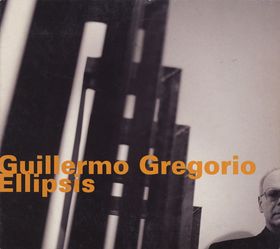Random Noise 13


Random Noise 13
Flogging the obvious, obviously
 We begin our brief tour with a good audio system. Add to this, of necessity, a good recording. My candidate is Ellipsis, with reed man-composer Guillermo Gregorio; Gene Coleman, bass clarinet; Jim O’Rourke, acoustic guitar and accordion; Carrie Biolo, vibes; Michael Cameron, acoustic bass; engineered by Steve Mezger, Airwave Recording Studios, Chicago, in 1997 [hatOLOGY CD 511, released in ’97]. The music, eight tracks of it, tends toward the cerebral-ethereal, with more than a passing resemblance to the twentieth-century’s vanguard classical. In terms of elegant detachment, this jazz musician – I assign the category less than confidently – calls Pierre Boulez to mind. When he’s at the top of his game, as he is here, Gregorio, an Argentinean who lives and plays in the Chicago area, creates a deep and luscious universe that rarely breaks a sweat. He has several hatART releases to his credit, all worth recommending.
We begin our brief tour with a good audio system. Add to this, of necessity, a good recording. My candidate is Ellipsis, with reed man-composer Guillermo Gregorio; Gene Coleman, bass clarinet; Jim O’Rourke, acoustic guitar and accordion; Carrie Biolo, vibes; Michael Cameron, acoustic bass; engineered by Steve Mezger, Airwave Recording Studios, Chicago, in 1997 [hatOLOGY CD 511, released in ’97]. The music, eight tracks of it, tends toward the cerebral-ethereal, with more than a passing resemblance to the twentieth-century’s vanguard classical. In terms of elegant detachment, this jazz musician – I assign the category less than confidently – calls Pierre Boulez to mind. When he’s at the top of his game, as he is here, Gregorio, an Argentinean who lives and plays in the Chicago area, creates a deep and luscious universe that rarely breaks a sweat. He has several hatART releases to his credit, all worth recommending.
When I listen to Ellipsis, and I have often, I think to myself, this is amazing music. And yet, having made the comparison, I’m aware that its vivid mystique diminishes when played on a system less good at resolution, transparency, timbral accuracy, dynamic finesse and a lifelike soundfield.
Inasmuch as I’m addressing audiophiles, in fact or aspiration, I’m flogging the obvious, obviously. Is there a point to be made? Perhaps, by reminding the reader that cheesy sound abounds, as do recordings of banal music, which is what makesEllipsis – and your now or future audio system – such an actual or anticipated pleasure. Think about it: what sense would we have of the wonderful absent the unexceptional?
But to further develop the point, let’s remain with poor sound. However fine one’s audio system, a sow’s ear remains a sow’s ear. A superior recording requires superior playback gear if one is to fully savor the recording’s superiority. Conversely, a poor recording (leaving the music’s quality aside) sounds like what it is – poor – however good the playback gear. To continue flogging the obvious obviously, who better than the audiophile to appreciate this?
Indeed, and the audiophile’s pursuit of good sound finds its expression in a library of favorite recordings, which is to say, a carefully assembled collection of discs, analog, digital, perhaps even open-reel tapes, that justify the trouble and expense he (or the rare she) has gone to. It must be said, however, that the audiophile’s music library can sometimes be mistaken for fuel: that which enables the hardware. To put it another way, the audiophile is often dismissed by the music lover as a dabbler. The gourmand’s credo, “If it smells good, eat it,” becomes “If it sounds good, play it.”
I’ve met a few audiophiles who meet this unenviable standard. After a desultory chat about componentry, there isn’t much to discuss. And I’ve met a few audiophiles I don’t hesitate to call stone-devoted music freaks. To describe a friend and fellow journalist, Dan Davis, as a fastidious audiophile doesn’t half say it. He’s also a great fan of mono recordings, originals and reissues. I’d sooner collect produce-crate labels. In the matter of devotion, I defer to Dan. Fürtwangler, Cortot, and Caruso discs loom large in his affections, and, purely in terms of sound, he’s downright fond of late-mono Deccas. (You can sample Dan’s writing about music at my Web site, LaFolia.com. He also covers new CDs for The Absolute Sound and audio topics forUltraAudio.com, where I had a nice, cozy berth until SoundStage’s management discovered my ad in the back pages of the Coprophagy Quarterly.)
![]()
 Johannes BRAHMS: Symphony No. 1 in C minor.Bergräbnisgesant. Schicksalslied. Felix MENDELSSOHN: Mitten wir in Leben sind. John Eliot Gardiner conducting the Orchestre Révolutionnaire et Romantique and Monteverdi Choir. Soli Deo Gloria CD SDG 702, released in 2008.
Johannes BRAHMS: Symphony No. 1 in C minor.Bergräbnisgesant. Schicksalslied. Felix MENDELSSOHN: Mitten wir in Leben sind. John Eliot Gardiner conducting the Orchestre Révolutionnaire et Romantique and Monteverdi Choir. Soli Deo Gloria CD SDG 702, released in 2008.
I first became aware of Monteverdi Productions’ Soli Deo Gloria label when John Eliot Gardiner and benefactors picked up the Bach cantata project Archiv dropped at the new century’s turn. (I’ve covered this excellent series for Random Noise on several occasions.)
Briefly, Gardiner, with his superb instrumental ensemble, the English Baroque Soloists, his likewise superb Monteverdi Choir, and a shifting roster of yet again fine vocal soloists, launched what Gardiner calls a Bach Pilgrimage, consisting of live cantata performances and recordings thereof in churches, cathedrals and chapels in Great Britain and the Continent, and finally, New York City. The pilgrimage concluded in late December, 2000 in Manhattan’s St. Bart’s with three single-disc volumes of Christmas-season cantatas, not including the Christmas Oratorio, for which I recommend a Gardiner performance with the English Baroque Soloists, Monteverdi Choir and soloists on Archiv 423232-2, released in 1987. Meanwhile, if all goes according to schedule, the SDG cantata project, in fourteen two-CD and three single-CD volumes to date, will have culminated in 2010.
Since the label’s very name, Soli Deo Gloria, looks to the Pilgrimage’s devotional aspect, I was surprised by the present program’s appearance as an SDG release. The extravagantly titled Orchestre Révolutionnaire et Romantique, another Gardiner creation, is well known for its Beethoven and Berlioz recordings on, for example, the Archiv and Philips labels. (A complete Gardiner discography includes Erato, Decca and Deutsche Grammophon, and now, of course, SDG.) I suppose we can expect forthcoming Gardiner performances, sacred and profane, as SDG releases. If a musician, in this case a justly celebrated conductor, has the backing and means, top-to-bottom control over one’s recordings trumps major-label whims and vagaries, driven in large part by accountants’ admonitions.
The present CD’s tasteful packaging resembles that of the cantata series: a sturdy, book-like enclosure with notes in English, with German and French translations. Rather than Steve McCurry’s remarkable photo-portraits of men, women and children in exotic tribal dress, the Brahms disc features on its cover and flyleaf a characteristically striking Howard Hodgkin painting, The Sky’s the Limit (2002). A thoughtful choice: Hodgkin is one of Britain’s leading painters.
But of course none of this would matter were the performances other than fine. Robert and Clara Schumann stand in musical history as Brahms’ early champions. It’s interesting, then, more as an irony, that readings of Schumann’s symphonies, like those of Brahms, can be turgid and bombastic in the hands of mediocre conductors and ensembles and, while we’re at it, recording engineers.
So then, what especially delights this listener is the sense of freshness Gardiner brings to the task. The symphony’s monumental outer movements notwithstanding, the conductor and his instrumentalists provide us with something quite apart from the usual sit-up-straight-and-listen-because-this-is-great-stuff performance. Call it suppleness, a lightness of touch, and most tellingly, an obvious affection for the music. Gardiner’s interpretation makes the music sound new, no mean accomplishment. Were the old Schwann Catalog still in existence, I’d be willing to bet that the First’s recordings would occupy the better part of a page. How many of them would be available is something else again. With respect to a rosy future, classical music’s right up there with the polar bear.
For the listener whose tastes center on modernist art music (now largely history,pace Helmut Lachenmann et al.), another Brahms’ First doesn’t set one’s pulse to racing, but then, most conductors and soloists feel obliged to prove their chops with classical’s core repertoire. And the performance is, to repeat, endearing. I wish I could be more enthusiastic about the sound. In synaesthetic terms, Brahms’ orchestral writing calls for warm, plushly textured earth tones. “Autumnal” is the oft used descriptive. Whether the venue, the Royal Festival Hall in London, or Engineer Mike Hatch of Floating Earth Ltd produced what I hear as a coolish, somewhat hard-edged blue particularly in evidence when the strings play loud, I cannot say: a small disappointment in an otherwise rewarding experience.
According to his notes, Gardiner included two choral-orchestral pieces as precursors to a symphony Brahms composed only when the composer felt confident enough to enter an arena where Beethoven’s spirit cast so intimidating a shadow. The Mendelssohn, while delightful, seems a curious filler. No complaints about the Monteverdi Choir’s sound. Here the engineering impresses, as does the choir’s obvious excellence.
Note: House Plant, the potted object at the top of the page, is an assemblage from a recent showing of my work at the Aarhus Gallery in Belfast, Maine (aarhusgallery.com).
Ars longa, vida brevis.

![]()
Don’t forget to bookmark us! (CTRL-SHFT-D)
Stereo Times Masthead
Publisher/Founder
Clement Perry
Editor
Dave Thomas
Senior Editors
Frank Alles, Mike Girardi, Key Kim, Russell Lichter, Terry London, Moreno Mitchell, Paul Szabady, Bill Wells, Mike Wright, Stephen Yan, and Rob Dockery
Current Contributors
David Abramson, Tim Barrall, Dave Allison, Ron Cook, Lewis Dardick, Dan Secula, Don Shaulis, Greg Simmons, Eric Teh, Greg Voth, Richard Willie, Ed Van Winkle, and Rob Dockery
Music Reviewers:
Carlos Sanchez, John Jonczyk, John Sprung and Russell Lichter
Site Management Clement Perry
Ad Designer: Martin Perry





Be the first to comment on: Random Noise 13